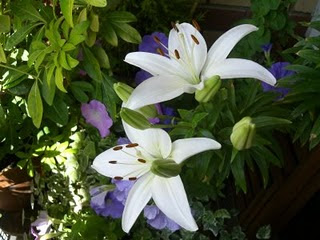 For those of us who reside in England's capital, exploring the 'great outdoors' is made very possible by the abundance of splendid public parks dotted around London. Those with a penchant for plants however, will find that their passions will be infinitely better served by a visit to London's globally-renowned Kew Gardens.
For those of us who reside in England's capital, exploring the 'great outdoors' is made very possible by the abundance of splendid public parks dotted around London. Those with a penchant for plants however, will find that their passions will be infinitely better served by a visit to London's globally-renowned Kew Gardens.Within easy reach for Londoners and visitors to the capital alike, the historic Royal Botanical Gardens in Kew offers an authentic escape from the trappings of city life and the opportunity to marvel at trees, plants and flowers from all over the world.
This Sunday (26th June), I went to visit Kew Gardens for an afternoon of walking, talking and photography and wanted to share my experiences with my faithful readers!
The first thing that strikes you about Kew Gardens is its sheer size. I have been to Kew Gardens several times before and yet each time find myself discovering a new grove, garden or area. And of course, visiting at various times of the year provides an unending source of interest, as colours, flowers and plants ebb and flow with the seasons.
Today, I started by entering the gardens at the Lion Gate, which is closest to my house. I walked past the ever-impressive Pagoda, which can be seen from far away outside the gardens! I strolled up through the boiling afternoon to the Japanese Gateway, which always impresses me. I have always found Japanese gardens highly interesting, both visually and philosophically, and the glorious summer weather made the spectacle even more impressive, as I hope this photograph testifies:

 My fiancé and I then walked up through the Woodland Glade until we came to the lake, which was veritably teeming with wildlife in the hot afternoon sun. Swans basked in the warmth, preening themselves along with their cygnets; geese pottered around nonchalantly and an army of dragonflies filled the air with a constant array of beautiful blue flashes, including the copulating couple seen below:
My fiancé and I then walked up through the Woodland Glade until we came to the lake, which was veritably teeming with wildlife in the hot afternoon sun. Swans basked in the warmth, preening themselves along with their cygnets; geese pottered around nonchalantly and an army of dragonflies filled the air with a constant array of beautiful blue flashes, including the copulating couple seen below:


 We proceeded along various paths, stopping to enjoy a much-needed orange drink and a refreshing ice-cream from one of the many cafes hidden away within the grounds. Further walking afforded us the opportunity to see many of Kew's glorious trees, the greens and golds looking truly spectacular against the backdrop of the bluest sky I've seen this year.
We proceeded along various paths, stopping to enjoy a much-needed orange drink and a refreshing ice-cream from one of the many cafes hidden away within the grounds. Further walking afforded us the opportunity to see many of Kew's glorious trees, the greens and golds looking truly spectacular against the backdrop of the bluest sky I've seen this year. And of course, no visit to Kew is complete without visiting the truly iconic Palm House:
And of course, no visit to Kew is complete without visiting the truly iconic Palm House: Built back between 1844-48 by Richard Turner, the Palm House has been internationally recognised as the world's most important surviving Victorian glass and steel building – an impressive feat indeed. If one can brave the heat and humidity inside, one will be rewarded with a wide range of tropical plants from all over the world, including the world's largest 'pot plant'!
Built back between 1844-48 by Richard Turner, the Palm House has been internationally recognised as the world's most important surviving Victorian glass and steel building – an impressive feat indeed. If one can brave the heat and humidity inside, one will be rewarded with a wide range of tropical plants from all over the world, including the world's largest 'pot plant'!There's no escaping the fact that Kew Gardens is both a beautiful place to visit and a site of extreme importance. For several hundreds of years, Londoners and botanists from all over the world have striven to make the gardens a centre of excellence in the field of plants and flowers. When one visits Kew, once can't help but be moved by the years and years of passion, skill and care that are evident in each and every one of the plants and trees.
For those of you resident in the capital, an annual season ticket costs £41 (£71 for a joint membership), which, at £3.41 per month, is less than a pint of your favourite ale! I would urge you, if you have never been to Kew, then go – it is a truly magical, timeless place that I hold dear in my heart and its memories will live with anyone who treads its hallowed turf.
